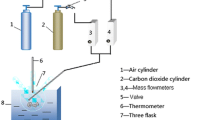Abstract
Wet flue gas desulfurization was simulated to improve gypsum production using low-grade limestone. High-grade limestone with 94 wt% CaCO3 content is used for producing gypsum with 93 wt% purity, but owing to the resource depletion of high-grade limestone, low-grade limestone should be replaced as an alternative. However, low-grade limestone with CaCO3 purity of less than 94% contains impurities such as MgCO3, Al2O3, and SiO2, which reduce gypsum purity. To resolve this issue, a process involving mixing of both low-grade and high-grade limestone was simulated to predict the quantity of low-grade limestone that could be utilized. Many reactions like limestone dissolution, SOX absorption, and crystallization were considered and were simulated by different models in Aspen plus. For process optimization, the following constraints were set: 93 wt% gypsum purity, 94% desulfurization efficiency, and 3,710 kg/h total limestone usage, which maximized the mass flow of low-grade limestone. The maximum blending quantity of low-grade limestone for 2,100 kg high-grade limestone that satisfied the constraints was ∼1,610 kg.
Similar content being viewed by others
References
G. Cheng and C. X. Zhang, Pol. J. Environ. Stud., 27, 481 (2018).
M. A. Gostomczyk and W. Kordylewski, ARCH COMBUST, 30, 15 (2010).
E. K. Oh, J. Korea Society of Environmental Administration, 9, 187 (2003).
C. Carletti, C. Blasio, E. Mäkilä, J. Salonen and T. Westerlund, Ind. Eng. Chem. Res., 54, 9783 (2015).
T. Recelj and J. Golob, Process Saf. Environ. Prot., 82, 371 (2004).
R. Krzyżyńska and Y. Zhao, Polish J. Environ. Stud., 19, 1255 (2010).
L. E. Kallinikos, E. I. Farsari, D. N. Spartinos and N. G. Papayannakos, Fuel Process. Technol., 91, 1794 (2010).
S. S. Park, H. S. Ahn, K. H. Kim, S. W. Yun and K. K. Park, J. Korea Soc. Waste Manag., 2010, 125 (2010).
H. S. Kim, Korea Patent, 10-2012-0018757 (2012).
J. H. Ahn, Korea Patent, 10-2015-0061150 (2015).
H. S. Kim, Y. I. Yun, H. K. Li and S. H. Kim, J. Korean Ind. Eng. Chem., 13, 468 (2002).
J. H. Kim, K. J. Tak and I. Moon, Ind. Eng. Chem. Res., 51, 10191 (2012).
V. Russo, T. Salmi, C. Carletti, D. Murzin, T. Westerlund, R. Tesser and H. Grénman, Ind. Eng. Chem. Res., 56, 13254 (2017).
S. Gu, B. Fu, T. Fujita and J. W. Ahn, Appl. Sci., 9, 2262 (2019).
Y. Yin, Q. J. R Meteorol. Soc., 131, 221 (2005).
S. S. Park, J. P. Hong, Y. M. Ahn, S. Y. Park and H. M. Uhm, J. Korean Soc. Environ. Eng., 22, 1407 (2000).
B. N. Kim, Trans. Korean Soc. Mech. Eng., A, 97 (2003).
J. Katolicky and M. Jicha, Heat Transf. Eng., KJ3, 57 (2007).
X. Ma, T. Kaneko, T. Tashimo, T. Yoshida and K. Kato, Chem. Eng. Sci., 55, 4643 (2000).
K. J. Tak, I. K. Lee, H. E. Kwon, J. H. Kim, D. H. Ko and I. Moon, Ind. Eng. Chem. Res., 54, 9992 (2015).
H. Jo, D. S. Uh, U. M. Choi and M. W. Han, Korean Chem. Eng. Res., 50, 270 (2012).
Acknowledgement
This study has been conducted with the support of the Korea Institute of Industrial Technology as “Development of Gas-phase pollutant removal technology using low temperature de-NOx catalyst and low energy-consuming CO2 absorbent based on quantum mechanics simulation (kitech EO-19-0011)” and “Development of AI Platform Technology for Smart Chemical Process (kitech JH-20-0005)”.
Author information
Authors and Affiliations
Corresponding author
Rights and permissions
About this article
Cite this article
Lim, J., Choi, Y., Kim, G. et al. Modeling of the wet flue gas desulfurization system to utilize low-grade limestone. Korean J. Chem. Eng. 37, 2085–2093 (2020). https://doi.org/10.1007/s11814-020-0639-6
Received:
Revised:
Accepted:
Published:
Issue Date:
DOI: https://doi.org/10.1007/s11814-020-0639-6




